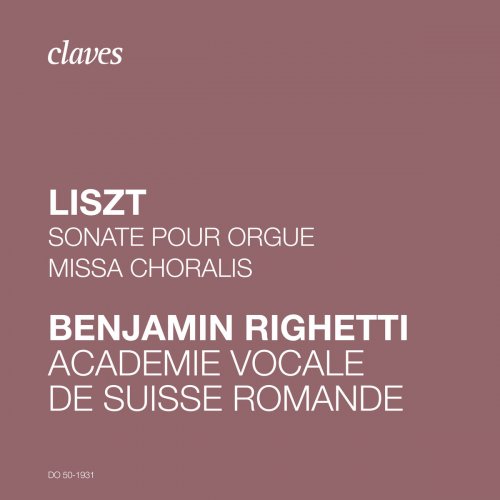
Benjamin Righetti - Franz Liszt: Sonate pour orgue & Missa Choralis (2019)
BAND/ARTIST: Benjamin Righetti
- Title: Franz Liszt: Sonate pour orgue & Missa Choralis
- Year Of Release: 2019
- Label: Claves Records
- Genre: Classical
- Quality: FLAC (tracks)
- Total Time: 62:10 min
- Total Size: 216 MB
- WebSite: Album Preview
Tracklist:
01. Grande Sonate pour le pianoforte, S. 178 (Arr by Benjamin Righetti)
02. Missa Choralis pour choeur et orgue, S. 10: I. Kyrie
03. Missa Choralis pour choeur et orgue, S. 10: II. Gloria
04. Missa Choralis pour choeur et orgue, S. 10: III. Credo
05. Missa Choralis pour choeur et orgue, S. 10: IV. Sanctus
06. Missa Choralis pour choeur et orgue, S. 10: V. Benedictus
07. Missa Choralis pour choeur et orgue, S. 10: VI. Agnus Dei
01. Grande Sonate pour le pianoforte, S. 178 (Arr by Benjamin Righetti)
02. Missa Choralis pour choeur et orgue, S. 10: I. Kyrie
03. Missa Choralis pour choeur et orgue, S. 10: II. Gloria
04. Missa Choralis pour choeur et orgue, S. 10: III. Credo
05. Missa Choralis pour choeur et orgue, S. 10: IV. Sanctus
06. Missa Choralis pour choeur et orgue, S. 10: V. Benedictus
07. Missa Choralis pour choeur et orgue, S. 10: VI. Agnus Dei
While in this year 2011 each of us measures Franz Liszt's impact on the 200 years that have passed since birth, two well-known sentences could sum up the thoughts that guided my own journey on this subject. First of all, Richard Wagner, saying of Liszt: "He can never confine himself to reproducing. Everything in him tends to pure, absolute creation. And then Liszt himself, maybe even synthesizing the same idea by saying simply: "For me everything is future. In approaching the Lisztian repertoire and in light of these quotations, it is interesting to ask what is probably the fundamental question of any interpreter: what sound reality is hidden behind these written pages, transmitted from the past? Indeed, we must remember that from one era to another, from one personality to another, the keys of reading vary a lot to move from the score to the music.
Since the improvised musical practices - which only the reading and the assimilation of historical methods and an in-depth knowledge of the time allow to glimpse - to the systems loaded with the most precise signs that it is only necessary to execute, to each time the same questions arise, with their lot of false certainties and beautiful uncertainties! In the specific case of Liszt, as well as for the majority of his contemporaries, the musical idea is necessarily accompanied by its concrete realization. This is the direct consequence of a period of invention of complex new instrumental techniques, and the need to describe them precisely to transmit them, even if they accumulate signs and symbols. For example, what a century ago was still just a simple cipher calling for agreement, will be here perhaps translated by a good twenty notes drawing an arpeggio figure, rising or falling from a single momentum or several stages, accompanied by a stable or evolving nuance, of a joint ... And if this realization proves to be extremely minute for Liszt - as for example precisely in the manuscript of the Sonata - it is certainly necessary to transmit distinctly to its interpreters not a swarm of details, but a living sound reality, and thus to go beyond the very straitjacket of writing.
Since the improvised musical practices - which only the reading and the assimilation of historical methods and an in-depth knowledge of the time allow to glimpse - to the systems loaded with the most precise signs that it is only necessary to execute, to each time the same questions arise, with their lot of false certainties and beautiful uncertainties! In the specific case of Liszt, as well as for the majority of his contemporaries, the musical idea is necessarily accompanied by its concrete realization. This is the direct consequence of a period of invention of complex new instrumental techniques, and the need to describe them precisely to transmit them, even if they accumulate signs and symbols. For example, what a century ago was still just a simple cipher calling for agreement, will be here perhaps translated by a good twenty notes drawing an arpeggio figure, rising or falling from a single momentum or several stages, accompanied by a stable or evolving nuance, of a joint ... And if this realization proves to be extremely minute for Liszt - as for example precisely in the manuscript of the Sonata - it is certainly necessary to transmit distinctly to its interpreters not a swarm of details, but a living sound reality, and thus to go beyond the very straitjacket of writing.
Year 2019 | Classical | FLAC / APE
As a ISRA.CLOUD's PREMIUM member you will have the following benefits:
- Unlimited high speed downloads
- Download directly without waiting time
- Unlimited parallel downloads
- Support for download accelerators
- No advertising
- Resume broken downloads


